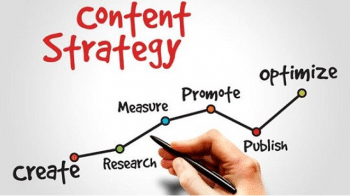Whether you’re new to content marketing or have been using the same technique for a while, it never hurts to update your content strategy plan – to ensure it’s current, original, and engaging for your prospects and consumers, no matter when or how they intend to buy.
The first step in getting a leg up on the competition — and actively engaging your audience — is to put in place a good, effective content marketing strategy.
Read on if you’re having problems planning for the future year or if you’re looking for some new ideas to incorporate into your plan. In this post, we’ll define content strategy, discuss why your company needs a content marketing plan, and outline the steps you’ll need to follow to construct your strategy. In addition, we’ll look at some examples of successful content marketing strategies in 2023.
What is Content Marketing Strategy?
A content marketing strategy starts with your business goals and then employs content as a major means of achieving those goals.
For example, your business goals could include raising brand awareness (to ultimately drive more income) — to accomplish this, you may create a content strategy that focuses on SEO to enhance website exposure on the SERPs and drive visitors to your products or services.
Early on, new business owners may believe that a content strategy is a ‘nice-to-have,’ but not fully necessary. Producing high-quality content to fit business needs, on the other hand, can help firms gain trust with new audiences and, ultimately, prosper in the long run.
Furthermore, with 70% of marketers actively spending on content marketing, developing a robust content strategy is often crucial if you want to compete in your business.
How to Plan a Content Marketing Campaign Strategy
Now, let’s get into the intricacies of creating a content marketing plan.
#1. Define your objective.
What is your goal in creating a content marketing strategy? Why do you want to create content and develop a content marketing strategy? Knowing your goals before you start planning will help you determine what’s best for your strategy.
#2. Carry out persona research.
To create a successful strategy, you must first determine your content’s target audience, often known as your buyer persona.
This is especially significant for people who are just getting started in marketing. Understanding your target audience allows you to create more relevant and valuable content that they will want to read and convert on.
#3. Conduct a content audit.
Most individuals begin with blog entries, but if you want to branch out and create other types of content, think about which ones you want to create.
For example, if you’ve been writing weekly blog entries for the previous year, developing an ebook that compiles all of your blog entries into one definitive guide would be one method to provide information in a different manner. Further down the list, we’ll go through various other forms of content you can employ.
If you’ve been in the company for a while, conduct a content audit to assess your content marketing efforts and results over the last year. Determine what you can do differently in the coming year and create new targets to achieve. Now is an excellent opportunity to match your team’s goals with those of your corporation as a whole.
#4. Decide on a content management system.
Have a content management system in place that allows you to generate, manage, and track your content (CMS). Content generation, content dissemination, and content analytics are all important aspects of content management.
#5. Create a list of content ideas.
It’s now time to start brainstorming ideas for your next content production.
Here are some resources to get your wheels turning:
- HubSpot’s Website Grader
- BlogAbout
- HubSpot’s Blog Ideas Generator
- Feedly
- BuzzSumo
- Blog Post Headline Analyzer
#6. Choose the sorts of material you wish to generate.
There are numerous alternatives for materials that you can produce. In the section that follows, we’ll go over some of the most common content marketing strategies that marketers are developing the strategy in 2023, as well as some tools and templates to get you started.
#7. Manage and publish your content.
Your marketing strategy should include more than just the kind of content you’ll develop; it should also include how you’ll organize that material. You’ll be on the correct road with an editorial schedule if you want to publish a well-balanced and diverse content collection on your website. Then, construct a social media content schedule to help you market and manage your content across several platforms.
Many of your ideas will be evergreen, meaning they will be just as relevant months from now as they are today. That being said, you should not disregard current events. While they may not constitute the majority of your content schedule, they can assist you in generating visitor surges.
So, if there are specialized holidays that would be of interest to your audience, it may be worthwhile to produce information on your blog or social media. Check out for a comprehensive list of social media holidays — keep it in mind as you arrange your calendar.
Questions To Answer Before Starting Out
- What problem do you offer the solution?
- Who are your target audience?
- In relation to a product, What is your value proposition?
- Which channel will you use for publishing your content?
- How will you manage content creation and pubication ?
Examples of Content Marketing Strategy in 2023
To further grasp a content strategy, let’s look at some examples of real-world content marketing strategies in 2023 based on a few different business goals.
To begin, consider an example of a content marketing strategy utilized for SEO (with the ultimate goal of attracting new prospects to a website).
#1. Evernote
I’m a major fan of Evernote’s blog, which provides a plethora of productivity advice. The blog piece, How To Stay Disciplined When Times Are Tough, made me laugh out loud — and then compelled me to grab a notepad and jot down some of the best recommendations.
But why is a note-taking app firm writing about discipline?
Because that’s how I found their website when I Googled “How to Stay Disciplined.”
Evernote is an excellent example of a content approach for attracting new leads. People who are interested in reading productivity content are likely to be interested in downloading Evernote’s note-taking product (because what’s better than a to-do list for keeping you on track?).
On the other hand, if Evernote’s marketing team merely published content to increase traffic — such as releasing “Our 10 Favorite Beyonce Songs” — it would not be considered a content strategy at all; it would simply be content.
In Evernote’s case, the strategy matches content (blog articles on productivity) with the business aim of driving leads (people interested in note-taking) to their site.
Let’s look at another example of how a smart content strategy may assist firms with sales marketing in 2023.
#2. Wistia
Consider the following scenario: a prospect calls a Wistia sales representative and inquires about the company’s video hosting service. As the Wistia sales rep speaks with her, he discovers that her company uses a few other tools to convert leads into sales… Intercom is included.
After the call, the sales rep sends the prospect an email with a link to a blog post about Wistia’s integration with Intercom, which allows Intercom users to further personalize messages to prospects based on video-watching data collected by Wistia.
This is an excellent example of how a content strategy can be used as a sales enablement tool. On the surface, it may appear strange that Wistia has content dedicated to another company’s tool. This content, on the other hand, is a great resource for Wistia’s sales team, especially when prospects have questions about how Wistia’s product will integrate with their existing software or processes.
Now that we’ve looked at a few examples of content strategies, let’s look at the various types of content marketing.
Content Marketing Types
- Blog posts
- Ebooks
- Case studies
- Templates
- Infographics
- Videos
- Podcasts
- Social media
These are the eight most popular content marketing strategies you may develop for your readers and consumers in 2023.
#1. Blog Posts
You’re currently reading a blog article if you haven’t noticed before. Blog entries are live on a website and should be produced frequently to attract new visitors.
Posts should deliver valuable content to your audience, enticing them to share it on social media and on other websites. We recommend that blog posts be between 1,000 and 2,000 words long, but you should experiment to see if your readership prefers longer or shorter reading.
#2. Ebooks
Ebooks are lead-generation products that potential customers can download after filling out a lead form with their contact information. They are often longer, more in-depth, and published less regularly than blog articles, which are created to attract visitors to a website.
Fortunately, you may use ebooks for a variety of purposes based on the objectives of your organization.
An ebook in this category may delve deeper into a specific problem and solution alternatives, as well as offer templates or calculators. Finally, as you progress down the funnel, ebooks should become more personalized and give more sales content. Prospects would benefit from comparison guides or an ebook of case studies at this level.”
Ebooks are the next step in the inbound marketing process: after reading a blog post (such as this one), visitors may demand additional information.
This is where calls-to-action (CTAs) come into play. It brings consumers to a landing page where they can submit their contact information and download an ebook to learn additional valuable information for their business. So, this results in a new lead for the sales team to approach.
#3. Case Studies
Case studies are your chance to tell the story of a customer who solved a problem by working with you. They are perhaps your most versatile type of content marketing strategy because they can take many different forms. That’s right, case studies can take the form of a blog post, ebook, podcast, or even an infographic.
Before selecting a customer for a case study, you should decide which form the testimonial will take and the area of your business to which you’re trying to drive value.
#4. Templates
Templates are a useful content format to try because they generate leads for you while providing tremendous value to your audience. When you provide your audience with template tools to save them time and help them succeed, they are more likely to engage with your content in the future.
#5. Infographics
Infographics can organize and visualize data in a more compelling way than words alone. Thus, this makes them excellent content formats to use if you need to share a large amount of data in a clear and understandable manner.
If you’re ready to get started, download our templates for producing great infographics in less than an hour.
#6. Videos
Videos are a highly engaging content medium that is shareable across social media platforms and websites alike. They require a larger investment of time and resources than written content, but as visual marketing grows in popularity. After all, it’s 40X more likely to be shared on social media than other types of content. It’s a medium worth experimenting with.
According to HubSpot Research, video is the most favored type of content, capturing people’s attention more than any other medium.
#7. Podcasts
Starting a podcast will help audiences find your brand if they don’t have time or interest in reading content every day. The number of podcast listeners is growing. In 2018, nearly one-third of the U.S. population had listened to a podcast in the previous month.
If you have interesting people to interview or conversations to host, consider podcasting as another content format to experiment with.
After you’ve been regularly publishing content on your own site for a while, it may be time to consider distributing your content on other sites. This could include repurposing content into new formats and publishing it on your blog, creating original content specifically for external sites, or publishing website content on various social networks.
Posting on social media, on the other hand, is critical to expanding your brand’s reach and delivering your content to your customers where you know they spend their time. Social networks on which businesses frequently post include:
- Snapchat
- Tik Tok
- YouTube
When launching a business account on any of the social networks mentioned above, it’s critical to post the type of content your followers expect to see. For example, on Instagram, users want photos, videos, and graphics that reflect current events, show off user-generated content, or even go behind the scenes of your organization.
On Facebook, you have more options for what to post. Not only can you share your blog posts and website content, but you can also post native Facebook videos, product promotions, and original memes that resonate with your customers. You can as well as interact with other businesses that have a similar audience as yours. While the goal of social media sites like Instagram or Snapchat is to connect more intimately with your audience, the goal of platforms like Facebook and Twitter is to expand that audience, drive traffic to your website, and start conversations in your industry. Do some standard market research to discover the platforms your buyers are on and create your content to their expectations.
How do you ensure that your content marketing strategy aligns with your overall business goals and objectives?
Ensuring alignment between the content marketing strategy and the overall business goals and objectives involves regularly reviewing the strategy and its impact on the business. This can be achieved by setting specific, measurable goals for the content marketing strategy and regularly tracking progress against these goals. Additionally, the content marketing strategy should be regularly reviewed and refined in response to changes in the business environment and the needs of the target audience.
How do you measure and analyze the engagement of your target audience with your content?
Tracking metrics like website traffic, social media engagement, email open and click-through rates, and conversions is necessary for measuring and analyzing engagement with your content. This information may be used to better understand the target audience, what motivates engagement, and how the content marketing plan can be adjusted by analyzing the data.
What are the ethical considerations for a content marketing strategy?
As part of an ethical content marketing plan, it is important to avoid deceptive or misleading tactics, protect the privacy of the target audience, and ensure that all material is truthful and accurately depicts the goods or services being advertised. The content must also be free of offensive or discriminatory language and must not violate the rights of others to their intellectual property.
How do you incorporate video into your content marketing strategy?
Making captivating and interesting video content that supports the overall marketing message and appeals to the target audience is necessary when using video into a content marketing plan. This can be accomplished using a range of media types, including explanation videos, product demos, client success stories, and live streaming. To reach the intended audience, the video material should be promoted through appropriate channels and optimized for social media and search engines.
How do you create a content calendar and plan your content production schedule?
A content calendar is a planning tool that specifies the material that will be created and released as well as the timing of those actions. The steps involved in creating a content calendar include deciding on the proper channels for promoting the content, the topics and formats for the material, and the target audience. The production timetable for content should be based on the content calendar and allow enough time for the material’s research, creation, editing, and promotion.
How do you continually evaluate and improve your content marketing strategy?
The metrics and data associated with the content marketing activities, such as website traffic, social media engagement, email open and click-through rates, and conversions, must be frequently reviewed in order to continuously evaluate and improve the content marketing strategy. To find opportunities for improvement, this data should be evaluated to determine the channels and content kinds that are most effective with the target audience. The content marketing strategy should then be adjusted and updated in light of this information to maintain its efficacy and consistency with the overarching goals and objectives of the company.
Summary
Building a successful content marketing strategy takes time, organization, and creativity. From laying the strategy for your strategy to adding tools to better manage your content, setting up your strategy for the new year won’t be a chore if you follow the steps and explore the resources here.
Good luck with your creation!
Content Marketing Strategy FAQs
How do I create a content marketing strategy?
11 Steps to Create a Content Marketing Strategy to Grow Your Business
- Set Your Mission and Your Goals.
- Establish Your KPIs.
- Know Your Audience.
- Assess Your Current Position.
- Figure Out the Best Content Channels.
- Decide on Content Types.
- Identify and Allocate Resources.
- Create a Content Calendar
What are the 5 essential elements of a content marketing strategy?
5 Essential Elements of Successful Content Marketing Strategies
- Have a Clearly Defined Audience. Before outlining your content marketing strategy, you need to have a clear picture of your target audience. …
- A Content Marketing Strategy with SMART Goals. …
- Clear Value Proposition. …
- Branding. …
- Metrics for Success
What is the first step of content marketing?
Here’s how to develop a content marketing strategy in 10 steps:
- Establish Your Goals and Objectives.
- Get to Know Your Target Audience.
- Perform a Competitive Analysis.
- Assess Your Available Resources.
- Conduct Topic and Keyword Research.
- Document Your Strategies and Tactics.
- Inventory and Audit Your Existing Content
What is a good content strategy?
A good content strategy considers a KPI, and then works towards reaching it. It is a roadmap that plans out the exact steps that need to be taken in order to reach that goal. But of course, even with all the best planning and execution, sometimes, content campaigns don’t meet their KPIs






